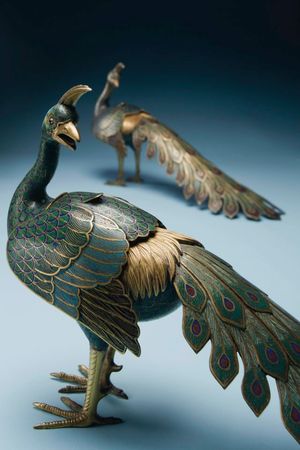A very rare pair of cloisonné enamel peacock censers. Qianlong period (1736-1795)
A very rare pair of cloisonné enamel peacock censers. Qianlong period (1736-1795). Photo: Christie's Images Ltd 2012
The peacocks are naturalistically modelled standing on clawed feet detailed with cylindrical bands, the heads topped by gilt feathered crests and with pointed gilt beaks turning sharply back looking towards their long trailing tails of overlapping feathers. They are intricately enamelled in shades of turquoise, blue and red with gilt wire highlights, the back and wings are decorated with colourful feathers forming a detachable cover for the hollow body and with a raised tab for the release of incense vapour. 17 3/8 in. (44.1 cm.) long (2). Lot 3909. Estimate: HK$3,000,000-5,000,000/ US$385,600-643,000). Price Realised HK$8,420,000 ($1,089,795)
Notes: Incense burners in the form of peacocks are very rare; compare with three single examples, the first from Mrs L. E. Redding, sold at Sotheby's London, 14 December 1971, lot 5; the second sold at Sotheby's London, 21 May 1963, lot 102; the third from the C. Ruxton and Audrey B. Love Collection, sold at Christie's New York, 20 October 2004, lot 588. A pair of similar censers was sold at Christie's Hong Kong, 30 May 2006, lot 1283.
Compare the fine sculptural form to similar metalwork dating to the Qianlong period. See for example the gilt-copper crane modelled supporting on its back a pavilion-shaped musical clock, included in the exhibition Moments of Eternity, Timepieces Collection from the Palace Museum, Macau Museum of Art, 2004, and illustrated in the Catalogue, p. 111, no. 27. Although in gilt-copper, the stance of the bird with its spiralling neck turned towards it back, and the detailing of the feathers compare closely with the present peacocks.
Peacocks are considered auspicious birds and it is known that such birds were kept by Emperor Qianlong in the palace grounds. A large hanging scroll entitled: Qianlong guan kong que kai ping, 'Emperor Qianlong watching the Peacock in its pride', dated to the cyclical wuyin year (1758) depicts a scene of the seated Emperor observing peacocks in the imperial gardens, seePaintings of the Court Artists of the Qing Court, The Complete Collection of the Treasures of the Palace Museum, Hong Kong, 1996, pp. 194-195. The inscription on the painting recorded by the Emperor indicates that peacocks were sent as tributary gifts from foreign dignitaries. The Emperor further noted on the painting that when at leisure he took pleasure in watching these curious birds sway their bodies around the palace grounds; he admired their beautiful feathers and after five years of nurture, the birds had learned to fan their tails.
Christie's. Masterpieces of the Enameller's Art from the Mandel Collection. 30 May 2012. Convention Hall

/https%3A%2F%2Fprofilepics.canalblog.com%2Fprofilepics%2F1%2F0%2F100183.jpg)
/https%3A%2F%2Fstorage.canalblog.com%2F03%2F02%2F119589%2F96711876_o.jpg)
/https%3A%2F%2Fstorage.canalblog.com%2F11%2F31%2F119589%2F94773502_o.jpg)
/https%3A%2F%2Fstorage.canalblog.com%2F20%2F83%2F119589%2F94772815_o.jpg)
/https%3A%2F%2Fstorage.canalblog.com%2F26%2F72%2F119589%2F75604929_o.jpg)
/https%3A%2F%2Fstorage.canalblog.com%2F59%2F60%2F119589%2F26458628_o.jpg)




/http%3A%2F%2Fstorage.canalblog.com%2F98%2F98%2F119589%2F129097971_o.jpg)
/http%3A%2F%2Fstorage.canalblog.com%2F93%2F75%2F119589%2F128489120_o.jpg)
/http%3A%2F%2Fstorage.canalblog.com%2F09%2F29%2F119589%2F128488304_o.jpg)
/http%3A%2F%2Fstorage.canalblog.com%2F62%2F18%2F119589%2F128488091_o.jpg)